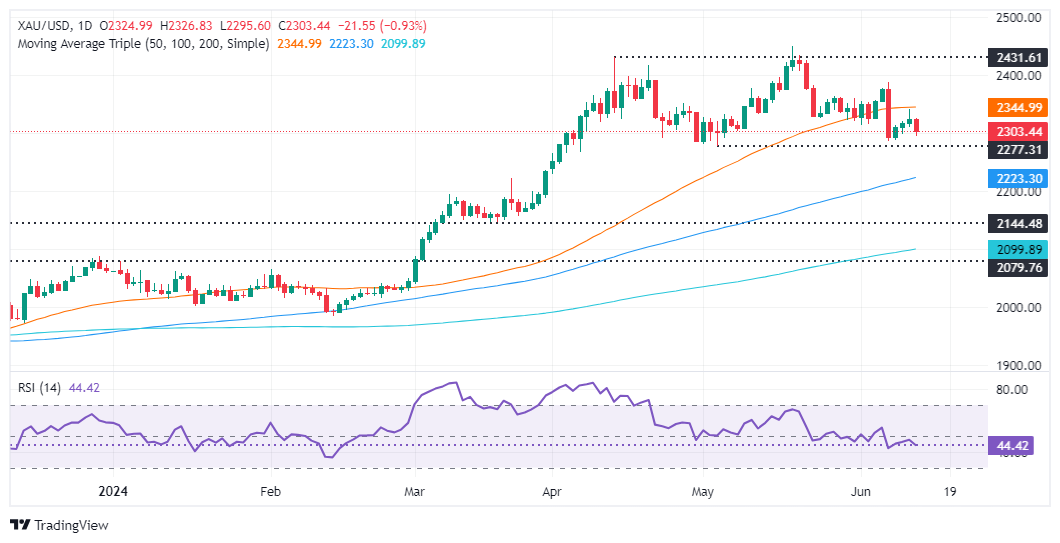- Gold retreats on its way toward $2,300 after hitting a daily high of $2,326.
- Fed's revised projections show just one rate cut in 2024, a headwind for XAU/USD prices.
- Lower producer prices and higher unemployment claims boost USD, 10-year Treasury yield drops to 4.242%.
Gold prices retreated during the North American session on Thursday after hitting a daily high of $2,326. The Federal Reserve (Fed) projects just one interest rate cut instead of the three proposed since December’s 2023 Summary of Economic Projections (SEP), aka the dot plot. In the meantime, mixed US economic data boosted the Greenback to the detriment of the golden metal.
The XAU/USD spot trades at $2,303, down almost 1%. US data from the Bureau of Labor Statistics (BLS) showed lower prices paid by producers, while the number of Americans applying for unemployment benefits exceeded estimates and the previous reading.
Although the figures suggest that the Fed could set the stage to lower interest rates, Fed officials estimate just 25 basis points (bps) of easing toward the end of 2024, according to the dot plot.
Despite that, according to data from the Chicago Board of Trade, market participants are eyeing 39 basis points of easing via December’s 2024 fed funds rate contract.
The US 10-year Treasury note yield dropped seven bps from 4.310% to 4.242%, usually a tailwind for the non-yielding metal that is feeling China’s Gold buying pause.
News that the People’s Bank of China paused its 18-month bullion buying spree weighed on the precious metal. PBOC holdings held steady at 72.80 million troy ounces of Gold in May.
On Wednesday, Fed Chair Jerome Powell stated that they are less confident about inflation than previously "in order to cut." He added, "If jobs are to weaken unexpectedly, the Fed is ready to respond." When asked about the US CPI report, Powell mentioned that it is just one and emphasized the need to see the deflation process evolving toward the Fed’s goal.
Daily digest market movers: Gold price tumbles after softer US data
- US Dollar Index (DXY) increased by 0.49% to 105.20, a headwind for Gold prices.
- US Producer Price Index (PPI) in May dipped from 0.5% to -0.2%, below estimates of 0.1% expansion.
- Core PPI in May was unchanged at 0%, below forecasts of a 0.3% expansion and beneath April’s 0.5%.
- Initial Jobless Claims for the week ending June 6 rose by 242K, above the consensus of 225K and the previous week's reading of 229K.
- Despite US CPI report showing disinflation process continuing, Fed Chair Jerome Powell commented that they remain “less confident” about the progress on inflation.
- Even though the latest US CPI and PPI reports were weaker than expected, the latest NFIB Small Business Optimism Index survey for May showed that businesses are struggling with higher prices and access to cheap financing.
Technical analysis: Gold price sellers regain control as prices are headed toward $2,300
The Gold price remains neutral to downwardly biased as the Head-and-Shoulders chart pattern remains in place, hinting that the non-yielding metal price is set for further losses. Momentum as measured by the Relative Strength Index (RSI) shows that sellers are in charge, an indication that once XAU/USD’s price drops below $2,300, lower prices lie ahead.
Gold’s first support would be $2,300. Once cleared the next stop would be the May 3 low of $2,277, followed by the March 21 high of $2,222. Further losses lie beneath, as sellers would eye the Head-and-Shoulders chart pattern objective at around $2,170 to $2,160.
On the flipside, if XAU/USD soars past the June 7 cycle high of $2.387, that paves the way to test the $2,400 figure.
Gold FAQs
Gold has played a key role in human’s history as it has been widely used as a store of value and medium of exchange. Currently, apart from its shine and usage for jewelry, the precious metal is widely seen as a safe-haven asset, meaning that it is considered a good investment during turbulent times. Gold is also widely seen as a hedge against inflation and against depreciating currencies as it doesn’t rely on any specific issuer or government.
Central banks are the biggest Gold holders. In their aim to support their currencies in turbulent times, central banks tend to diversify their reserves and buy Gold to improve the perceived strength of the economy and the currency. High Gold reserves can be a source of trust for a country’s solvency. Central banks added 1,136 tonnes of Gold worth around $70 billion to their reserves in 2022, according to data from the World Gold Council. This is the highest yearly purchase since records began. Central banks from emerging economies such as China, India and Turkey are quickly increasing their Gold reserves.
Gold has an inverse correlation with the US Dollar and US Treasuries, which are both major reserve and safe-haven assets. When the Dollar depreciates, Gold tends to rise, enabling investors and central banks to diversify their assets in turbulent times. Gold is also inversely correlated with risk assets. A rally in the stock market tends to weaken Gold price, while sell-offs in riskier markets tend to favor the precious metal.
The price can move due to a wide range of factors. Geopolitical instability or fears of a deep recession can quickly make Gold price escalate due to its safe-haven status. As a yield-less asset, Gold tends to rise with lower interest rates, while higher cost of money usually weighs down on the yellow metal. Still, most moves depend on how the US Dollar (USD) behaves as the asset is priced in dollars (XAU/USD). A strong Dollar tends to keep the price of Gold controlled, whereas a weaker Dollar is likely to push Gold prices up.
Information on these pages contains forward-looking statements that involve risks and uncertainties. Markets and instruments profiled on this page are for informational purposes only and should not in any way come across as a recommendation to buy or sell in these assets. You should do your own thorough research before making any investment decisions. FXStreet does not in any way guarantee that this information is free from mistakes, errors, or material misstatements. It also does not guarantee that this information is of a timely nature. Investing in Open Markets involves a great deal of risk, including the loss of all or a portion of your investment, as well as emotional distress. All risks, losses and costs associated with investing, including total loss of principal, are your responsibility. The views and opinions expressed in this article are those of the authors and do not necessarily reflect the official policy or position of FXStreet nor its advertisers. The author will not be held responsible for information that is found at the end of links posted on this page.
If not otherwise explicitly mentioned in the body of the article, at the time of writing, the author has no position in any stock mentioned in this article and no business relationship with any company mentioned. The author has not received compensation for writing this article, other than from FXStreet.
FXStreet and the author do not provide personalized recommendations. The author makes no representations as to the accuracy, completeness, or suitability of this information. FXStreet and the author will not be liable for any errors, omissions or any losses, injuries or damages arising from this information and its display or use. Errors and omissions excepted.
The author and FXStreet are not registered investment advisors and nothing in this article is intended to be investment advice.
Recommended content
Editors’ Picks

EUR/USD trades deep in red below 1.0300 after strong US jobs report
EUR/USD stays under bearish pressure and trades below 1.0300 in the American session on Friday. The US Dollar benefits from the upbeat jobs report, which showed an increase of 256,000 in Nonfarm Payrolls, and forces the pair to stay on the back foot heading into the weekend.

GBP/USD drops toward 1.2200 on broad USD demand
GBP/USD extends its weekly slide and trades at its weakest level since November 2023 below 1.2250. The data from the US showed that Nonfarm Payrolls rose by 256,000 in December, fuelling a US Dollar rally and weighing on the pair.

Gold ignores upbeat US data, approaches $2,700
Following a drop toward $2,660 with the immediate reaction to strong US employment data for December, Gold regained its traction and climbed towards $2,700. The risk-averse market atmosphere seems to be supporting XAU/USD despite renewed USD strength.

Sui bulls eyes for a new all-time high of $6.35
Sui price recovers most of its weekly losses and trades around $5.06 at the time of writing on Friday. On-chain metrics hint at a rally ahead as SUI’s long-to-short ratio reaches the highest level in over a month, and open interest is also rising.

Think ahead: Mixed inflation data
Core CPI data from the US next week could ease concerns about prolonged elevated inflation while in Central and Eastern Europe, inflation readings look set to remain high.

Best Forex Brokers with Low Spreads
VERIFIED Low spreads are crucial for reducing trading costs. Explore top Forex brokers offering competitive spreads and high leverage. Compare options for EUR/USD, GBP/USD, USD/JPY, and Gold.
